NORTH WALES COAST RAILWAY:NOTICE
BOARD
Rheilffordd arfordir gogledd Cymru: Hysbysfwrdd
14 July 2014
 Last issue
Last issue Archive
Archive Share this issue
Tweet
Tweets by @NWrail1
Contributions and comments are encouraged: see the Contributions Page
This site is dedicated to all our regular contributors and supporters, and especially the rail staff of North Wales.
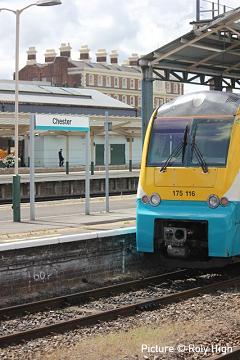
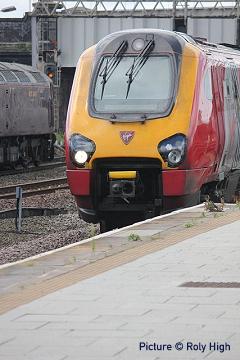
This list may be out of date if you are reading an archived page. For the current list visit our Calendar.
July 2014
Sunday 27 July Steam on the Coast. Railway Touring Company. 'North Wales Coast Express' Liverpool, Broad Green, Warrington BQ, Frodsham and Chester to Llandudno, Bangor and Holyhead.
Tuesday 29 July Steam on the Coast. Railway Touring Company. Welsh Mountaineer. Preston, Warrington BQ, Frodsham and Chester to Blaenau Ffestiniog.
August 2014
Sunday 3 August Steam on the Coast. Railway Touring Company. North Wales Coast Express Note change of route Crewe, Wilmslow, Stockport, Manchester Piccadilly, Warrington Bank Quay and Chester to Llandudno, Bangor and Holyhead. Diesel-hauled Crewe - Manchester.
Sunday 10 August Steam on the Coast. Railway Touring Company. North Wales Coast Express Note change of route Crewe, Wilmslow, Stockport, Manchester Piccadilly, Warrington Bank Quay and Chester to Llandudno, Bangor and Holyhead. Diesel-hauled Crewe - Manchester.
Sunday 17 August Steam on the Coast. Railway Touring Company. 'North Wales Coast Express' Liverpool, Broad Green, Warrington BQ, Frodsham and Chester to Llandudno, Bangor and Holyhead.
Tuesday 19 August Steam on the Coast. Railway Touring Company. Welsh Mountaineer. Preston, Warrington BQ, Frodsham and Chester to Blaenau Ffestiniog.
September 2014
Tuesday 2 September Steam on the Coast. Railway Touring Company. Welsh Mountaineer. Preston, Warrington BQ, Frodsham and Chester to Blaenau Ffestiniog.
Sunday 7 September Steam on the Coast. Railway Touring Company. North Wales Coast Express. Note change of route Crewe, Wilmslow, Stockport, Manchester Piccadilly, Warrington Bank Quay and Chester to Llandudno, Bangor and Holyhead. Diesel-hauled Crewe - Manchester.
Saturday 20 September Steam on the Coast. Steam Dreams: Cathedrals Express. London - Holyhead.
October 2014
Saturday - Monday 18-20 October Land Cruise Compass Tours Autumn Highlander. Holyhead, Llanfairpwll, Bangor, Llandudno Junction, Colwyn Bay, Rhyl, Flint, Chester, Delamere, Northwich, Knutsford, Altrincham, Stockport, Manchester Victoria, Bolton, Preston, & Carlisle to Inverness and Kyle of Lochalsh. A 3-day weekend break by rail to the Scottish Highlands, inclusive of two nights stay in quality hotel accommodation at Inverness. From £329.00 each.
November 2014
Saturday - Sunday 1/2 November Wirral 2014 Model Railway Exhibition at Mosslands School, Mosslands Drive, Wallasey, Wirral CH45 8PJ . 18 layouts, 13 traders, demonstrators and Society stands, refreshments, free vintage bus rides.
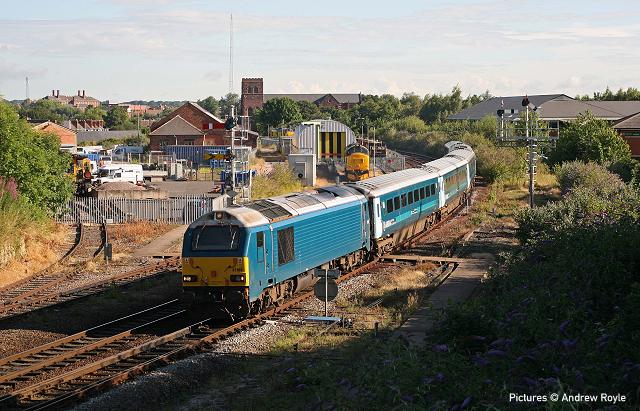
On 7 June, 67 003 hauls the morning Holyhead - Cardiff express out of Shrewsbury past the depot of the Class 97/3 'Cambrian ERTMS' locomotives.The left-hand (facing the driver) arm of Sutton Bridge Junction's home signal is lowered, indicating a clear route to the Hereford line; the right-hand arm is for the Cambrian line trains towards Welshpool, available only to trains with the ERTMS signalling system. Picture by Andrew Royle.
Royal Scotsman
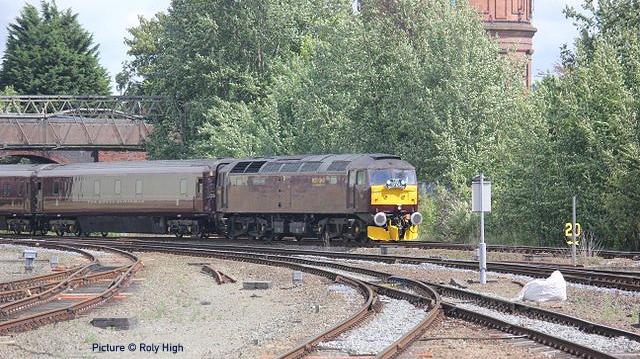
The Royal Scotsman (or Belmond Royal Scotsman to use its new official name) arrived in North Wales on 13 July on Day 3 of its annual 7-night 'Grand Tour of Britain.' Hauled by 47 854 Diamond Jubilee with 47 804 on the rear, it had departed from Dundee at 07:39 and arrived in Chester (above) at 15:11 (Picture by Roly High.)
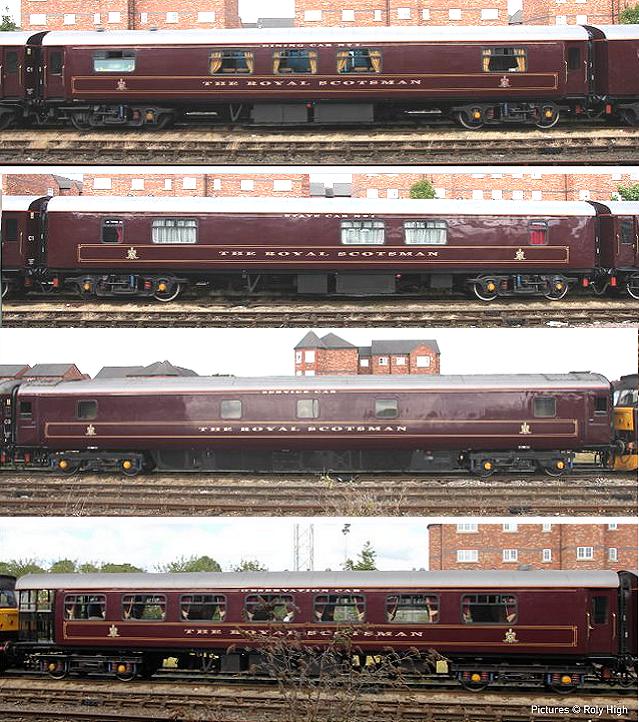
At Chester the whole train was turned on the triangle of lines to the west of the station, and shunted into the sidings for provisioning, including a visit by a water tanker. Meanwhile the passengers (all 21 of them) enjoyed a 'Historical walking tour of Chester, including a drinks reception in the Cathedral'.
The rolling stock of the 'Royal Scotsman' has changed a great deal since it first began its luxury tours in the 1980s using a mixture of Mk1 sleeping cars and interesting vintage carriages. Since 2013 it has been formed entirely of steel-bodied coaches meeting modern standards for main line running. Two are ex-British Rail Mk3 sleeping cars, used for staff accommodation except for two bedrooms in 'State Car no.5.' The other seven vehicles were built in 1960 by Metro-Cammell for Pullman services on the East Coast Main Line, all modified for their various used as 'State Cars' (sleeping accommodation), Dining Cars and the unique Observation Car with its open-air viewing platform. The Scot-Rail website has full details of the coach numbers, etc. Pictures by Roly High.
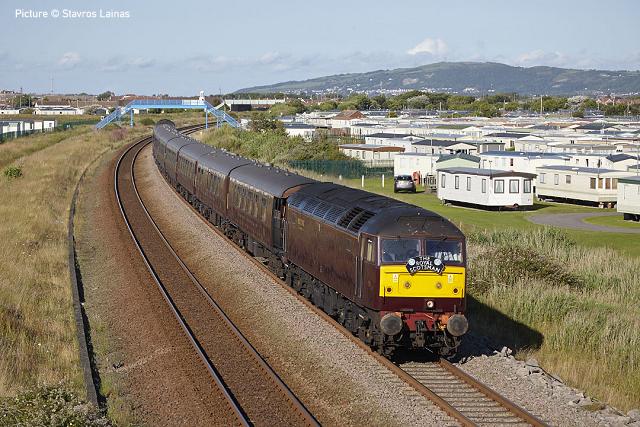
The train departed at 18:10 for North Wales, dinner being served on the train en route to the passing loop at North Llanrwst, chosen as a quiet location for an undisturbed sleep. Above, 47 804 is at the head of the train passing the caravans of Towyn at 18:38 (Stavros Lainas).
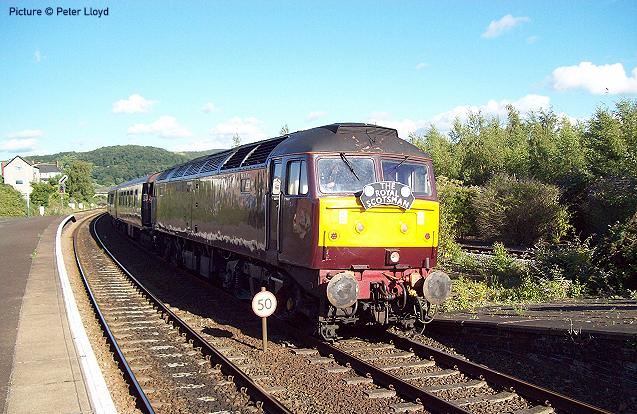
Arrival at Llandudno Junction (Peter Lloyd). The track in the disused, but still officially available, sidings in the background is now barely visible due to nature's takeover.
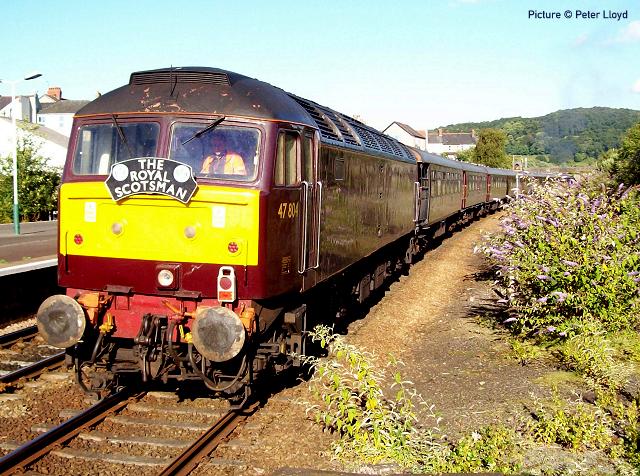
The train reversed at Llandudno Junction and headed for North Llanrwst. After dinner, there was time for a visit from North Llanrwst to nearby Gwydir Castle.
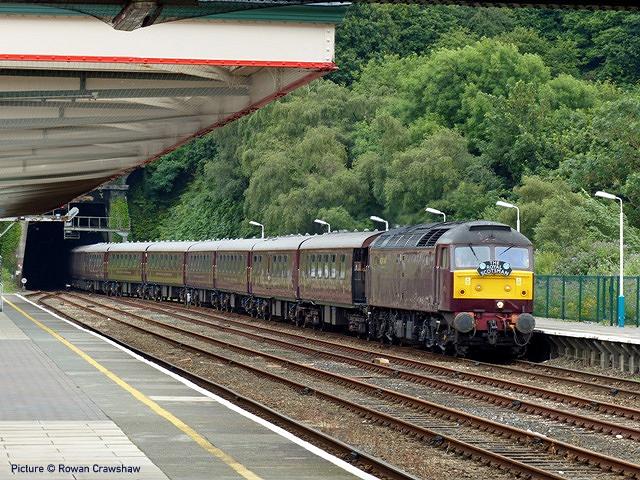
Monday 14 July saw the train travel to Bangor, where it was photographed by Rowan Crawshaw. The passengers enjoyed a visit Caernarfon Castle and the Welsh Highland Railway.

Meanwhile the train moved to Holyhead for servicing, and then back Llandudno to collect them for the next long leg of the tour, 19:50 Llandudno to Gloucester (arr 00:06). At Llandudno Junction, on arrival from Holyhead the train was held in the Up Passenger Loop line (above) for 20 minutes before heading down the Llandudno branch; platform 2 at Llandudno is not available for use at present as its surface is being re-flagged. Picture by Peter Lloyd.
Non-stop tourism...
Locomotive scenes
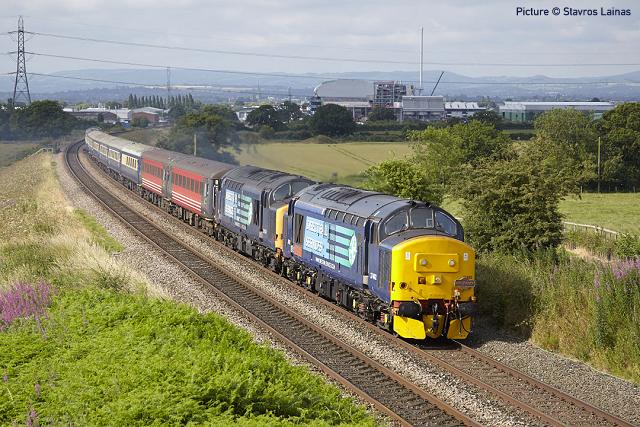
37 402 and 37 603 with a Pathfinder Tours Taunton to Carlisle excursion 'The Pennine Explorer' on 9 July, passing Battlefield, north of Shrewsbury (Stavros Lainas).
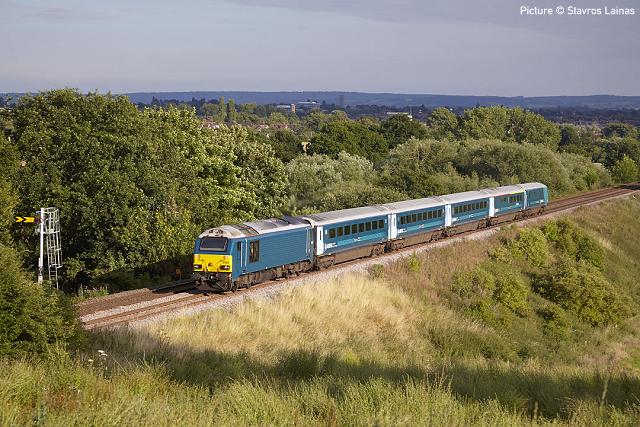
On 10 July, the Cardiff to Holyhead express with 67 003 leading is seen at Hencote Bank, near Shrewsbury at 19:15. The sun made an appearance just in the nick of time to make a quite dramatic shot (Stavros Lainas).
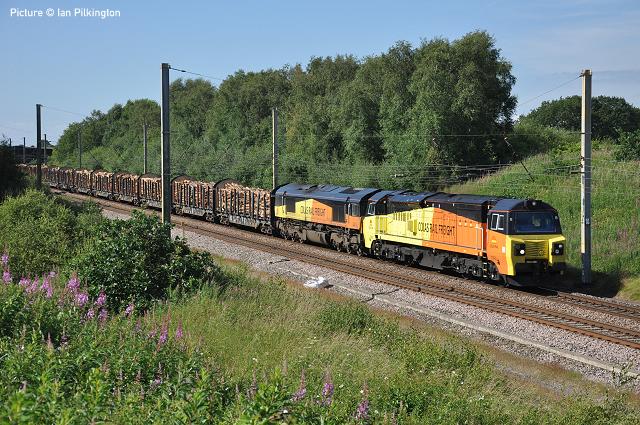
Colas Rail 70 802 (with 66 847 'dead
inside') heads train 6J37 Carlisle - Chirk logs past Bradley, north of
Wigan on Thursday 10 July. This was the first revenue-earning working
for a Colas 70 in the North, but we understand this was for evaluation
only, and Class 60 locos (recently purchased from DB Schenker) will be
used to power the logs when available in the near future. 70 802 was
removed at Warrington and 66 847 worked the train forward to North
Wales. Picture by Ian Pilkington.
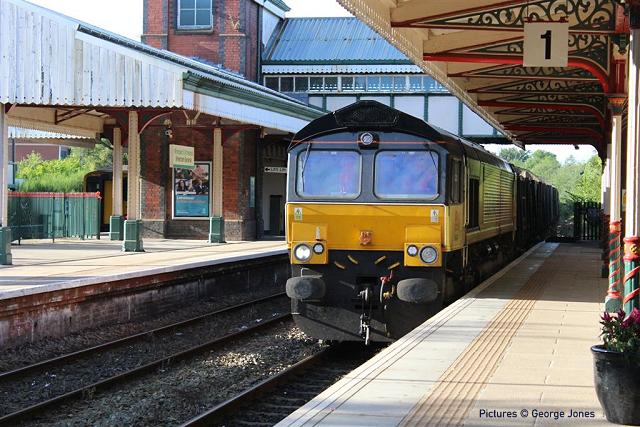
66 847 on the logs going solo at Wrexham General, on time and powering through for Chirk. Nicely lighted by the sun in the west (George Jones).
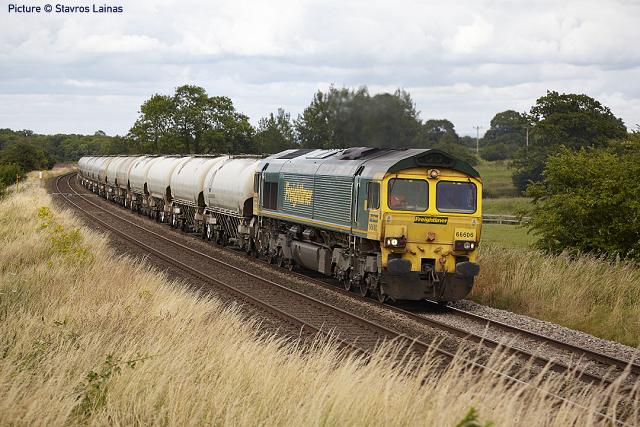
Stavros Lainas travelled to Whitchurch on 13 July to photograph 6V82, the Sundays-only cement train from Tunstead to Westbury passing at 16:51 with 66 606 in charge.
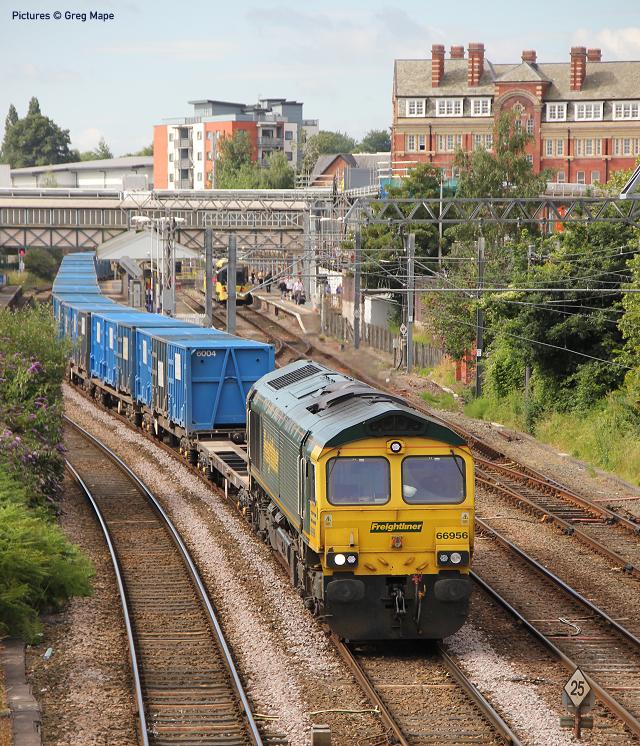
Monday 14 July saw two freight trains within 10 minutes of each other through Altrincham. At 10:07 66 956 heading for Brindle Heath waste terminal, Salford with empty containers from the new 'energy from waste' plant which has been opened on the chemical works site served by the Runcorn Folly Lane branch. This traffic from Greater Manchester seems to be getting into its stride now, after a somewhat erratic start with many trains cancelled. There has been talk in the past of opening a waste-loading terminal at Llandudno Junction and running trains to Folly lane from there, but nothing has transpired so far (Greg Mape).
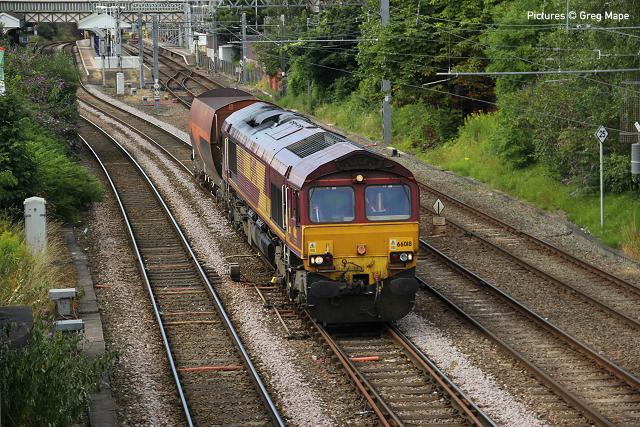
At 10:14, 66 018 with one ex-RMC ''JGA' bogie limestone hopper wagon, heading to Peak Forest South from Arpley Sidings, probably after repairs (Greg Mape).
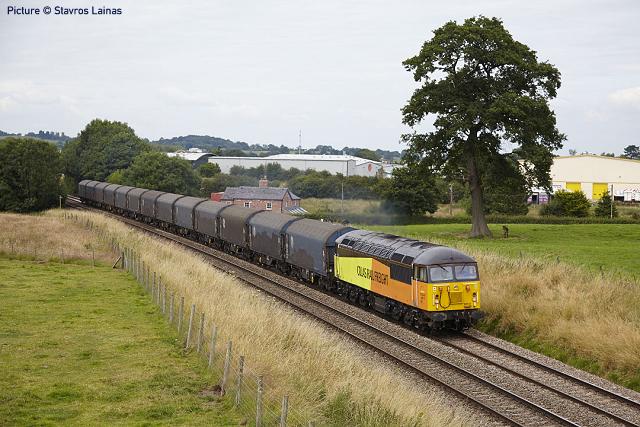
Colas 56 113 passing Whitchurch at 3.09pm with a trip from to Llanwern hauling a set of empty steel carriers on 11 July (Stavros Lainas).
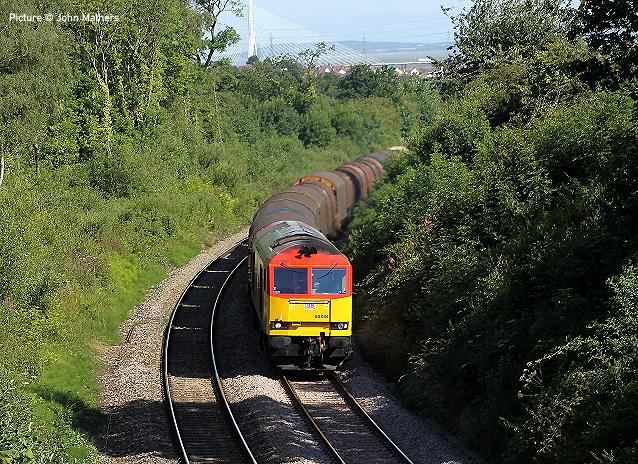
60 044 with train 6V75 Dee Marsh - Margam passes Plough Hill near Queensferry, with the Deeside Bridge on the horizon (John Mathers).
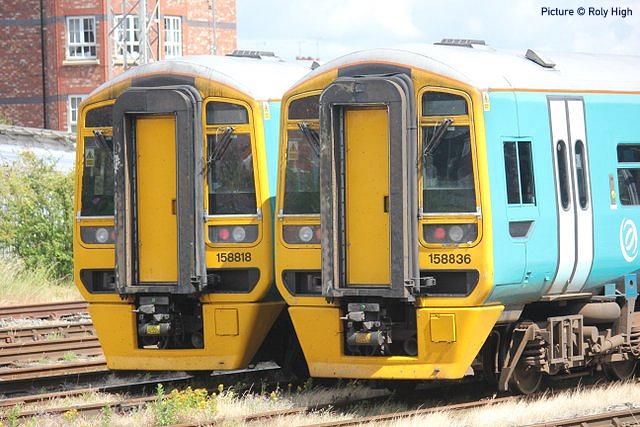

66 847 on the logs going solo at Wrexham General, on time and powering through for Chirk. Nicely lighted by the sun in the west (George Jones).

Stavros Lainas travelled to Whitchurch on 13 July to photograph 6V82, the Sundays-only cement train from Tunstead to Westbury passing at 16:51 with 66 606 in charge.

Monday 14 July saw two freight trains within 10 minutes of each other through Altrincham. At 10:07 66 956 heading for Brindle Heath waste terminal, Salford with empty containers from the new 'energy from waste' plant which has been opened on the chemical works site served by the Runcorn Folly Lane branch. This traffic from Greater Manchester seems to be getting into its stride now, after a somewhat erratic start with many trains cancelled. There has been talk in the past of opening a waste-loading terminal at Llandudno Junction and running trains to Folly lane from there, but nothing has transpired so far (Greg Mape).

At 10:14, 66 018 with one ex-RMC ''JGA' bogie limestone hopper wagon, heading to Peak Forest South from Arpley Sidings, probably after repairs (Greg Mape).

Colas 56 113 passing Whitchurch at 3.09pm with a trip from to Llanwern hauling a set of empty steel carriers on 11 July (Stavros Lainas).

60 044 with train 6V75 Dee Marsh - Margam passes Plough Hill near Queensferry, with the Deeside Bridge on the horizon (John Mathers).
Double Take

Chester, 13 July (Roly High).
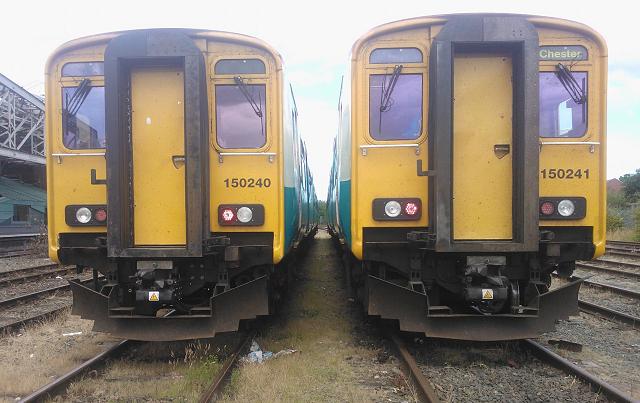
Chester, 29 June (as seen by a rail staff member).
Welshpool and Llanfair report - by Glyn Jones
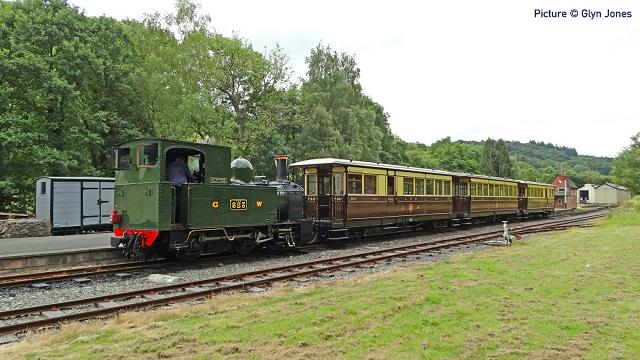
Sunday 13 July saw the railway turn out its splendid 'new build' coach set behind original locomotive 823 Countess, seen above on arrival with the 11.58 from Llanfair Caereinion.
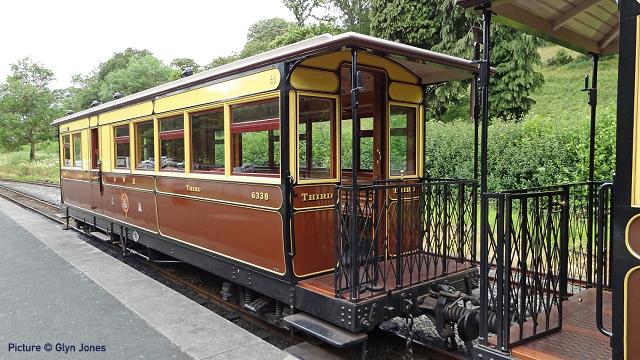
On the Railway’s opening in 1903, it purchased three carriages from R.Y. Pickering of Glasgow, comprising two brake composite and one all-third, running on American type bogies. When passenger services ceased in 1931, they were sent to Swindon for storage and eventually broken up in 1936. The Railway commissioned the Ffestiniog Railway to build a replica set at their Boston Lodge Works, these being built and delivered in 2004, 2007 & 2010. All are turned out in their post-1922 condition when the line was part of the Great Western Railway. Above, a closer look at brake third 6338.
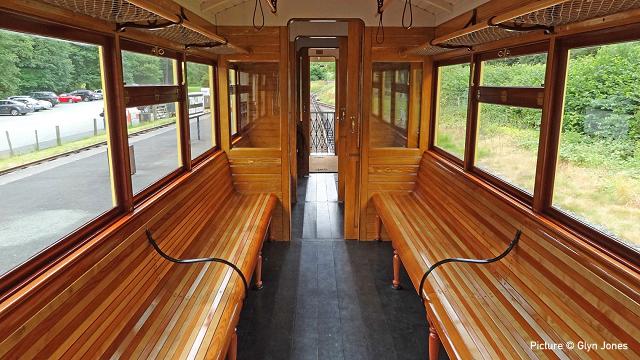
The authentic Edwardian interior of 6338.
Looking after the line
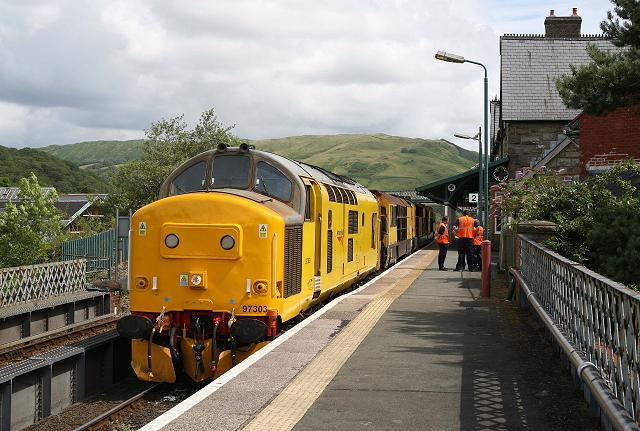
A mentioned above, anything entering the Cambrian system needs to have ERTMS signalling capability. Arriva's Class 158 passenger trains have this built in; any other train of any kind has to be piloted by one of the four Class 97/3 (former Class 37) locomotives equipped with the system, unless the section of line has been secured as a 'possession' for engineering work. This includes the various kinds of self-propelled track maintenance machines: at Machynlleth on 7 July (above) , 97 303 has arrived at Machynlleth station from Coleham (Shrewsbury) at 11:55 in charge of ...
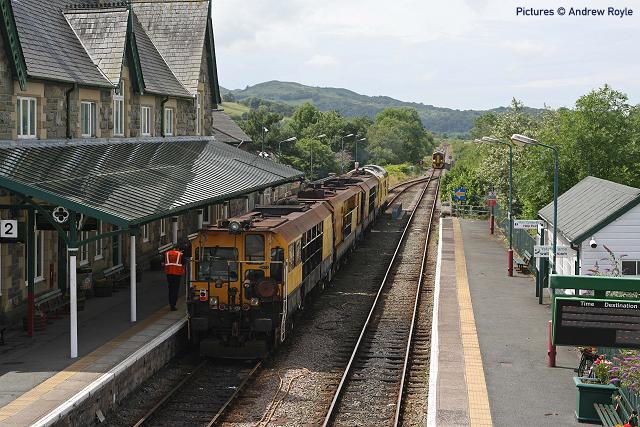
... DR79200, a Schweerbau SPML15 Rail Grinder. These machines are designed to ensure a smooth surface on the head of the rails, reducing noise and vibration and helping to prevent the development of cracks. In the distance, the 10:30 passenger train from Harlech approaches: a second 158 on the 11:30 from Aberystwyth will arrive and the two will couple to head to Birmingham International.
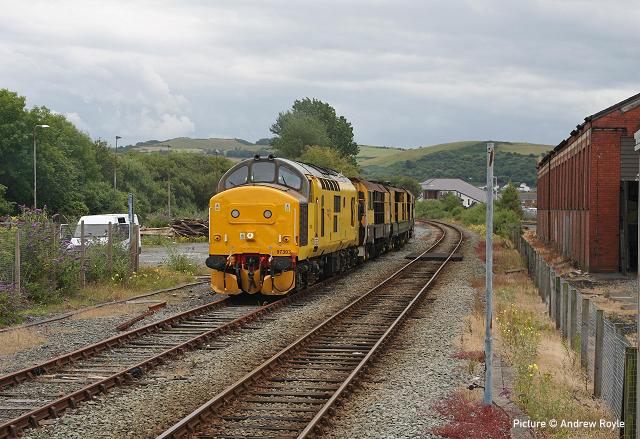
The grinding train was taken to Aberystwyth (above) ready to work in an overnight possession. 97 303 returned to the Shrewsbury depot in the afternoon. Pictures by Andrew Royle.
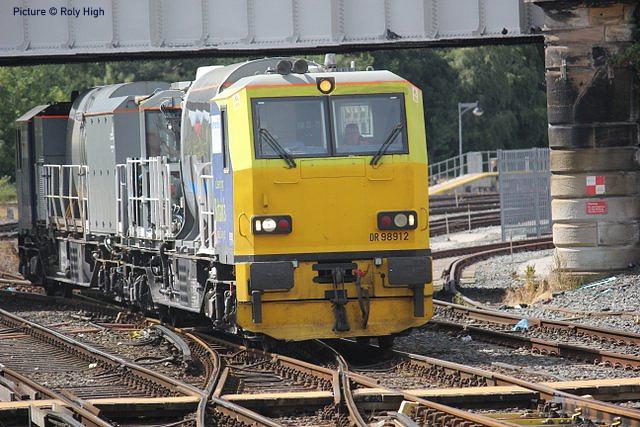
A different kind of maintenance vehicle is the German-built MPV - Multi-purpose vehicle - of which Network Rail have a considerable fleet. Always used in back-to-back pairs, they can carry various 'modules' on their load spaces; in autumn they mostly work as Rail Head Treatment Trains to overcome the 'leaves on the line' problem, whilst in summer, they can be called upon for Vegetation Control, a.k.a. weed-killing. DR 98912 is pictured at Chester on 13 July (Roly High).
Mold Junction Then and Now - by Dave Sallery
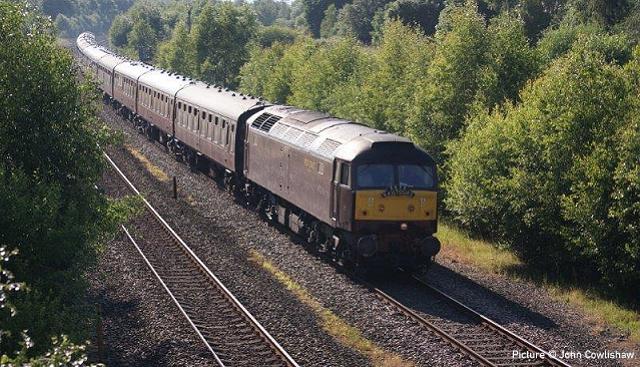
Dave Sallery writes: 'Looking at the photo by John Cowlishaw of 47804 at Mold Junction on 21 June (repeated above), I thought that a picture I took 30 years ago from the same location might offer a surprising contrast.
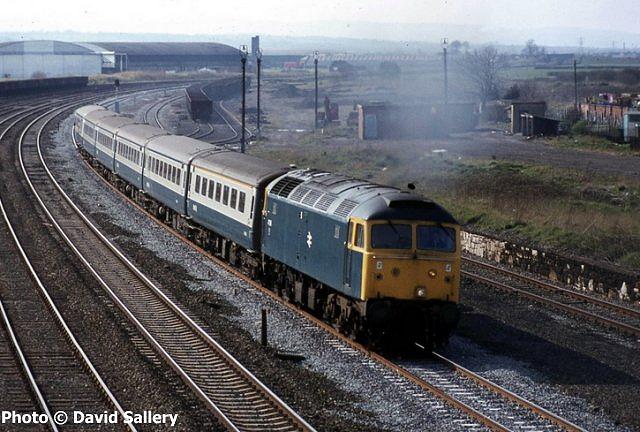
The locomotive hauling a London-bound train on 21 April 1984 was 47 425. By then the marshalling yard had already closed and was just used to stable permanent-way wagons containing used ballast which was dumped on the right-hand side. The observant passenger may still see that the loudspeakers, used to instruct shunters, are still in position on the left of the main line. Although they'll never crackle into life again!
The wooden post between the tracks connects the two pictures. We used to sit on the wharf on the right in the 60s, spotting on summer Saturdays. The highlight was the Sheffield - Llandudno with a B1 class 4-6-0 on it - happy days.
Corwen station update - by George Jones
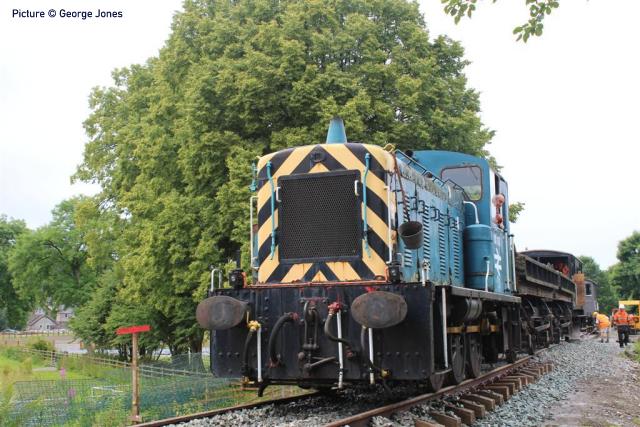
As of Tuesday, 8 July, the track extension at the Llangollen Railway's Dwyrain Corwen East station site has now received its top ballast. Thanks to consistent supplies of ballast from Penmaenmawr quarry, the top ballasting of the extension has proceeded apace and the job is complete ahead of estimates. The 03 shunter brought the 'Shark' brake van and two tipper wagons onto the station site to spread the ballast and place ash on the north side of the station site. This is the furthest west a train has proceeded so far. The railhead was extended at the Corwen East station site during week ending 28June and the stop block now sits by the access gate at the end of the phase 1 station site and the Toad mess van is in residence.
The services of the hired in tamper machine are now needed by the end of July, when further ballast supplies will be required to top up the formation once it is aligned and packed. In the meantime, there is plenty of spade work for the volunteer work force to fettle up the stone dropped but it may be that we can soon have another golden fishplate moment at the end of the line to celebrate the achievement.
Estimates for the building of the temporary platform with scaffolding are coming to hand from contractors, but a start date for construction has yet to be determined. There also remains the matter of building the graded access ramp off the embankment onto the approach road. However the footpaths from the car park have now been given a top coating and the poor weather approach is complete. The nature reserve access below the station site has been seeded with wild flowers and is closed to allow for germination.
The ‘snagging’ list continues to be worked on. The piping of culverts 25g & 25h which take surface water off the A5 has been completed and work on the road surface drainage has been tackled by Highways. Some 800 fishplates on the extension have all been greased, but further work is necessary to complete the list of items requiring attention.
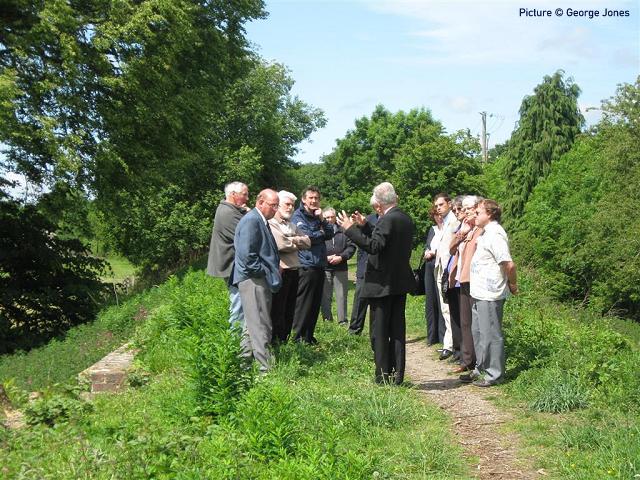
By way of contrast, the picture above was taken in June 2011 when Jim Ritchie was explaining to community leaders that the wilderness on the old trackbed would become the station site. The party is standing on the old underbridge 30 which disappeared as part of the Corwen Flood Alleviation Scheme – the spot where the 03 shunter is seen in the picture above. We did get there, but it has been a real challenge.
With a range of work still to be completed, the date for the start of passenger services still cannot yet be given but the recent achievement brings the opening ever nearer.
Wrexham Re-doubling activities
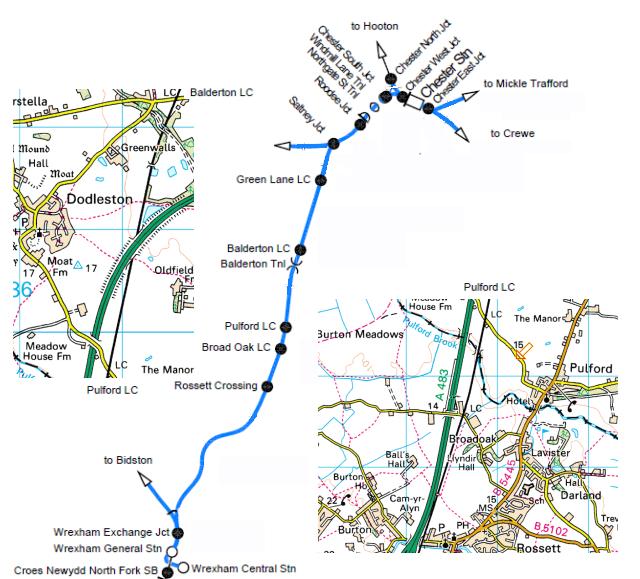
Recently our mailbox sees a regular influx of messages about the political, engineering and operational aspects of the track-doubling work which is on-going between Saltney Junction and Rossett, so we have assembled the map extracts above to help non-locals to locate the sites involved. Particularly controversial is Network Rail's suggestion that the level crossing at Broad Oak should be closed as its location does not meet safety standards for trains running at the proposed line speed.
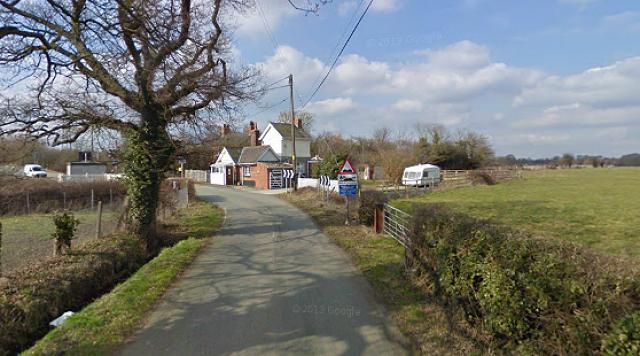
This Google Streetview picture shows the restricted view from the road on the approach to the crossing from the south-east, and the home which has been developed from the former crossing-keepers cottage. Network Rail seem to be suggesting that they can build a bridge, but it would be awkward to do, and whether this has been costed into the project is not clear.
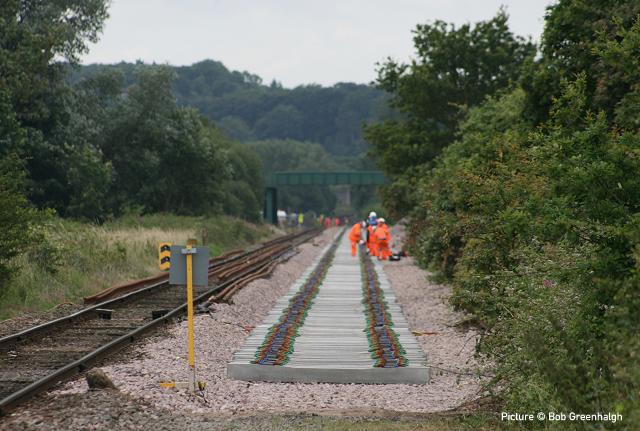
By rail, it is quite close to the crossings at Pulford to the north and Rossett to the south, but residents are concerned about the resulting increase in distance from their homes to their local village via the bridleway crossing or road bridge at Rossett, or via Pulford crossing.
Network Rail say: 'Having now identified the key issues, we are keen to meet users of Broad Oak level crossing to discuss the possible options in advance of making any final decisions. We invite members of the public to attend our community drop-in on Tuesday, July 29, from 3pm to 7pm at the Rossett and Burton Village Hall, Station Road, Rossett.'
The crossings enable our contributors to record the work: the picture above taken looking south from Broad Oak crossing looking south on 9 July shows how far the laying of sleepers had progressed. The footbridge seen in the distance carries a public footpath, which led to Rossett but appears to have been severed by the construction of the A483 by-pass which runs alongside the line behind the trees on the right, making the bridge useless. Or is there a way to cross the road?
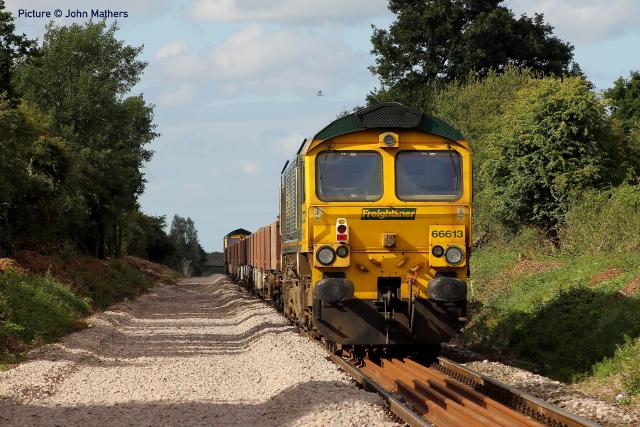
Seen on 14 July from Pulford level crossing on Dodleston Lane, new ballast awaits sleepers, and new rails lie in wait between the rails of the existing line. 66 613 sits on the rear of a Crewe Basford Hall - Rossett area engineers' train, with 66 554 at the Chester end of the train. Picture by John Mathers.
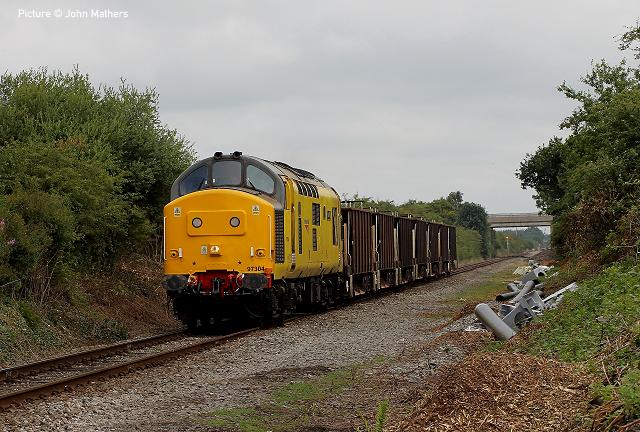
Balderton crossing on 9 July, with 97 304 on another run of what appears to be a test or training train to and from the Coleham depot of the 97/3 locos (John Mathers).
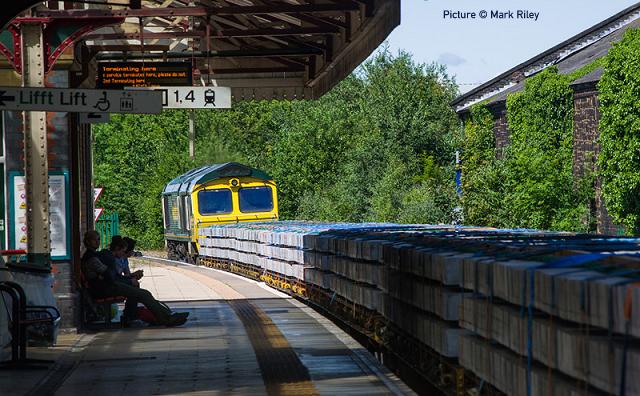
On 29 June, 66 596 passes Wrexham General with another Crewe Basford hall - Wrexham
train, consisting of nine wagons loaded with concrete sleepers, destined for the work site at Rossett. The people on the platform were unaware of the line closure and buses replacing trains to Chester, as has occurred each Sunday so far since the track improvement scheme started (Mark Riley).
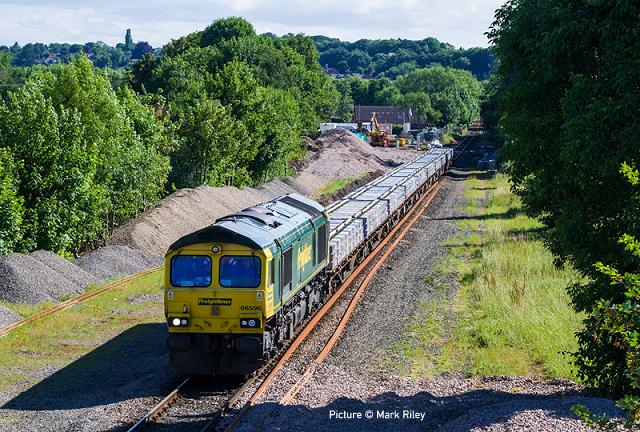
Just over an hour later, and 66 596 enters the possession at Rossett. A change to see a non-
ballast train (Mark Riley).
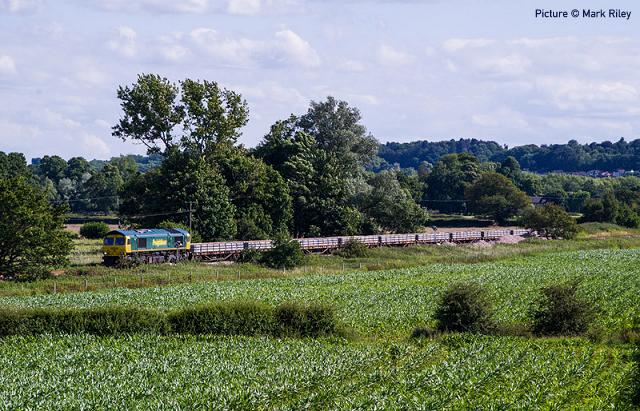
A different view from Cobblers Lane, just west of Broad Oak crossing, from an elevated position
where the road crosses over the A483 Wrexham By-Pass. The train is roughly half way between the footbridge and the crossing at this point (Mark Riley).
Two unusual sights

Rare diesel haulage for Ffestiniog Railway passengers on 7 July: The 11:35 Porthmadog to Blaenau Ffestiniog and 15:50 return was planned for haulage by steam locos Lyd and Linda but due to a lack of loco crew, Lyd was replaced by diesel Upnor Castle, seldom seen on passenger work, pictured (above) by Jack Bowley.
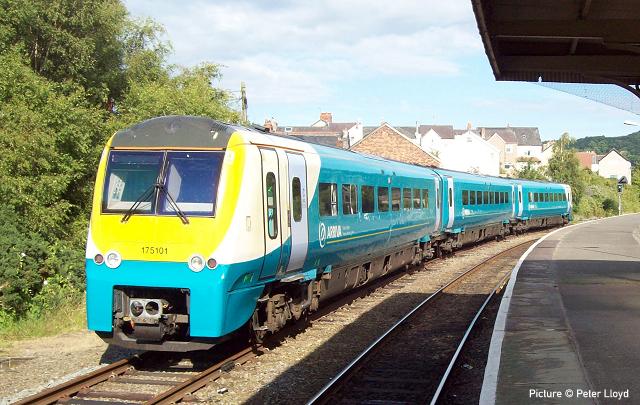
The 14:40 Llandudno to Manchester train had problems on 11 July, with a lot of smoke coming from the centre car. The train was evacuated at Deganwy and the fire service were called to the train which went forward empty to Llandudno Junction and moved into the tamper siding for inspection. A problem with the exhaust was found, and fitter's attention the train went forward to Chester depot as 5T01 at 17:55. Peter Lloyd photographed the departure.
Some things completely different

Mark Hambly writes: ' I recently celebrated my 'D400th' birthday and my family wanted to have a painting done for me by an artist we know locally. When asked what I'd like I requested something to do with the Llangollen Railway. Rachel Tighe's interpretation of the classic A5 view of Berwyn (attached) is certainly a railway picture, but very different from what one might perhaps see in a Guild of Railway Artists exhibition. I really like her style of work, more of which can be seen on her website at www.racheltighe.com.'
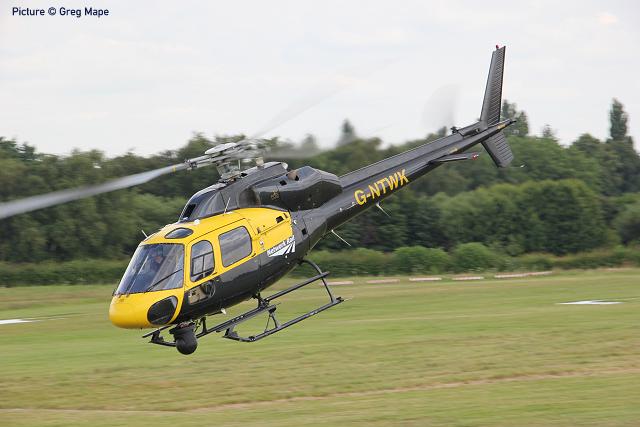
Greg Mape took this picture on 11 July while on a cycle ride to Barton Aerodrome ('City Airport Manchester'). Caught by chance just lifting off, Network Rail helicopter G-NTWK is an Aerospatiale AS355F2 Ecureuil II, operated by PDG Helicopters.
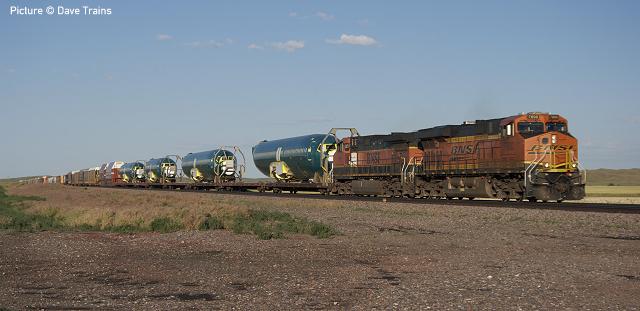
Still on aeronautical matters, this from North Wales driver Dave Trains. 'On my last visit to the USA - I often travel there to photograph trains - I came across the Boeing train with fuselage for Boeing 737s built at the Wichita plant and transported by rail to the Renton and Everett assembly plant near Seattle. Here the H-KCKSPO1-26A High priority merchandise train from Kansas city (Kansas) to Spokane (Washington) nears Alliance, Nebraska on 24 June running over 18 hours late with BNSF locos 7800 and 996 with 4 fuselages on board. '
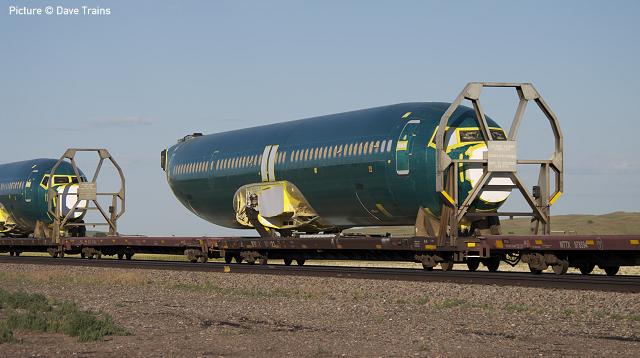
A new angle to the slogan 'take the train to catch the plane'. It was one of these trains that unfortunately derailed on 6 July, depositing three Boeing 737 fuselages into an adjacent river.
North Wales Coast home page | Archive | Previous Notice Board